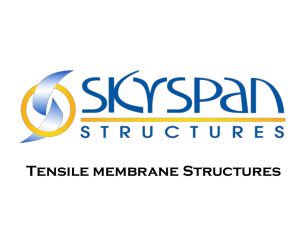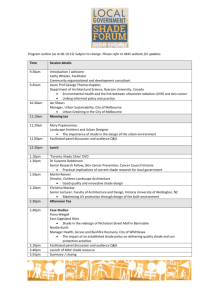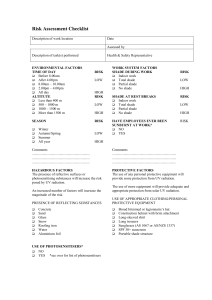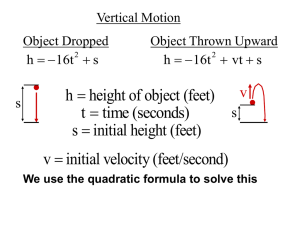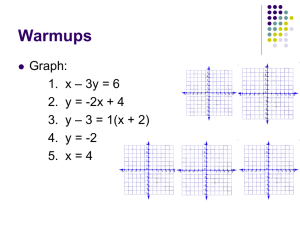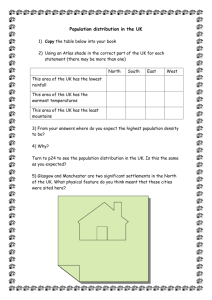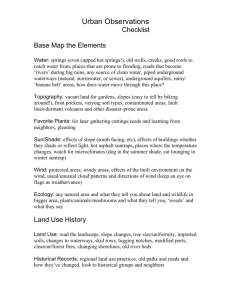SPECIFICATIONS - Fraser Shading Systems Inc.
advertisement
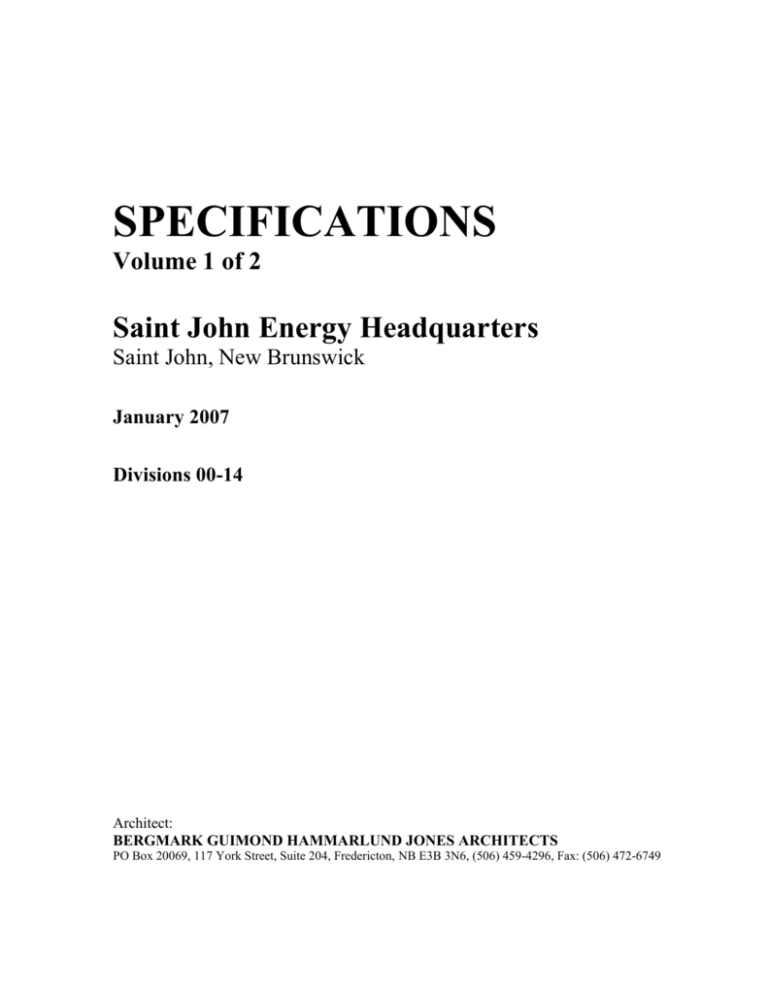
SPECIFICATIONS Volume 1 of 2 Saint John Energy Headquarters Saint John, New Brunswick January 2007 Divisions 00-14 Architect: BERGMARK GUIMOND HAMMARLUND JONES ARCHITECTS PO Box 20069, 117 York Street, Suite 204, Fredericton, NB E3B 3N6, (506) 459-4296, Fax: (506) 472-6749 Saint John Energy Headquarters Saint John, NB Project #191 Rolling Shades Section 12491 Page 1 January 2007 PART 1 – GENERAL 1.1 Summary 1. Work of this Section consists of furnishing all labor, materials, equipment and services necessary to complete the work indicated: 1. Interior, manually operated and/or motorized sun control and/or room darkening shades; including all accessories, fittings and fasteners. 1.2 Related Sections 1.3 References 1.4 Performance Requirements 1.5 Design 1. Section 02920 – Glazed Aluminum Curtain Walls 2. Section 06101 – Rough Carpentry 3. Section 09110 – Non-Load Bearing Wall Framing 4. Division 16 – Electrical 1. American Society for testing Materials (ASTM) 1. ASTM D 1784-99, Specification for Rigid PVC Poly Vinyl Compounds (PVC) and Chlorinated Poly Vinyl Compounds (CPVC) 2. ASTM G-22-80 Results for ATCC6538 and ATCC13388 indicating minimum 5mm “No Growth Contact Area” 3. ASTM G-285 results for ATCC9642, ATCC9644, ATCC9348 and ATCC9645 indicating “No Growth”. 1. Fire: Provide shade fabrics tested in accordance with NRPA 701 vertical burn test and rate “pass”. 2. Toxicity: Provide shade fabrics tested in accordance with University of Pittsburg Toxicity Protocol including LC50 analysis and toxicity characteristics. 1. Design roller shades to following requirements: 1. 2. Be designed in a manner that allows wear susceptible parts to be replaceable by either the user of the manufacturer. A guarantee of at least five years of available replacement parts following discontinue of the products manufacture. Saint John Energy Headquarters Saint John, NB Project #191 1.5 Design Requirements (Cont’d) 1.6 Submittals Rolling Shades 1. Section 12491 Page 2 January 2007 (Cont’d) 3. Be accompanied by instructions for replacing or repairing worn parts, including inventory numbers for parts and procedures for ordering replacement parts. 4. A program that allows for the refurbishing or return of used roller shades. 5. Be designed in a manner that permits effective disassembly of components in order to permit recycling of materials for which recycling markets exist. 6. Include stamps on all major plastic components indicating composition code to facilitate recycling efforts. 1. Submit manufacturer’s product data sheets, performance data and installation instructions for each item required. 2. Product Literature: Manufacturer’s product data sheets, specifications, performance data, physical properties and installation instructions for each item required. 1. Provide additional information for fabric; including size limitations, fire resistance information and toxicity information. 2. Identify available shadecloth colors, densities and weaves. 3. Include manufacturer’s proposed warranty; defining all terms, conditions and time periods for warranty coverage. 3. Shop Drawings: Dimensioned ¼” scale drawings including actual measurements taken at the project where practical. Include complete fabrication details and erection drawings. 4. Selection Samples: 3 by 5 inch shadecloth sample swatches indicating full range of colors, densities and weaves available for initial selection. 5. Wiring Diagrams and Schematics for Electrically Operated Units: Submit detailed wiring diagrams and schematics of the entire system; each component of the system with a detailed list of components, wiring schematics and operational characteristics for every level of operation. 6. Certificate of Compliance: Manufacturer shall submit notarized certificate of compliance indicating compliance with requirements of specifications; including statement that specified warranty will be provided without restriction. Manufacture shall certify that materials proposed for use comply with applicable building code and environmental regulations. Saint John Energy Headquarters Saint John, NB Project #191 1.7 Shop Drawings Rolling Shades Section 12491 Page 3 January 2007 1. Submit shop drawings in accordance with Section 01330 – Submittal Procedures. 2. Indicate dimensions in relation to window jambs, operator details, head and sill anchorage details, hardware and accessories details. 3. Head, sill and jamb details as necessary to coordinate work with surrounding conditions an construction. 4. Interior elevations indicating shade layout, seam/batten locations and coordination with surrounding conditions. 5. Shade schedule coordinating room number window type, open sizes, quantities and key to details. 1.8 Manufacturer’s Instructions 1. Manufacturer’s standard installation instructions. 1.9 Quality Assurance 1. Qualifications: 2. 1. Manufacturer: 20 years minimum experience manufacturing products comparable to those specified in this section. 2. Installer: 5 years minimum experience installing products comparable to those specified in this section. Field Samples: Install large size sample of selected fabric for final verification of color, weave and density, in opening as directed by Consultant. 3. Do not fabricate shades without obtaining field dimensions for each opening. Coordinate construction of surrounding conditions to allow for timely field dimension verification. 1.10 Delivery, Storage & Handling 1. Storage and Protection: 1. Do not deliver items to the project until all concrete, masonry, plaster, painting and other wet work has been completed and is dry. 2. Deliver shades to project in labeled protective packaging. Uniquely labeled to identify each shade for each opening. Schedule delivery to prevent delays to completion of work but to minimize on site storage time. Saint John Energy Headquarters Saint John, NB Project #191 1.10 Delivery, 1. Storage & Handling 1.11 Warranty 1.12 Samples Rolling Shades Section 12491 Page 4 January 2007 (Cont’d) 3. Store materials in a dry secure place. Protect from weather, surface contaminants, corrosion, construction traffic and all other potential damage. 1. Manual Operating Components: Provide manufacturer’s warranty under provisions of Division 1 – General Requirements. Warranty period to be 10 years from Date of Substantial Completion and contain provisions that installation is to remain operational without fault for the warranty period and include all operating parts, including shade cloth, except for the bead chain which is not covered by the warranty and is deemed to be a maintenance/service item. 2. Installation: Provide Contractor’s warranty under provisions of Division 1 – General Requirements that installation shall be free from defects for a period of not less than 1 year. 3. In the event of a warranted product failure, the Shade Contractor will, at no cost to owner, facilitate acquisition and delivery of all necessary components to the owner. 4. Motor and Electrical Components: Provide warranty under provisions of Division 1 – General Requirements. Warranty period shall be 2 years from Date of Substantial Completion. Warranty shall contain provisions that installation shall remain operational, without fault, for the warranty period; including coverage of motor, electrical controls and override circuits. 5. Shadecloth: Provide warranty under provisions of Division 1 – General Requirements. Warranty shall be for a minimum period of 10 years from Date of Substantial Completion. Warranty shall contain provisions that the shadecloth will not deteriorate, sag or warp and will not be unfit for the use intended for the warranty period. 1. Submit samples in accordance with Section 01330 – Submittal Procedures 2. Submit on representative working sample of each type shade. 3. Submit duplicate samples of manufacturer’s standard colors for selection by Consultant. 4. After approval, warranty shade samples will be returned for incorporation into the Work. 5. Submit 75 mm x 125 mm fabric samples of manufacturer’s full range of colors and fabrics. Saint John Energy Headquarters Saint John, NB Project #191 Rolling Shades Section 12491 Page 5 January 2007 PART 2 – PRODUCTS 2.1 Components 1. Standard of acceptance: MechoShade as manufactured by MechoShade Inc. 2. Shadebands: Construction of shadeband includes the fabric, the hembar and hempocket, and the attachment of the shadeband to the roller tube. 3. Single Fabric Shadecloth: Provide Thermoveil fabric group my MechoShade; a single thickness, non-raveling 0.030 inch thick vinyl fabric, woven from 0.18 inch diameter, extruded vinyl yarn/ comprised of 21% polyester and 79% reinforced vinyl. Provide colour, density and weave as selected by architect from manufacturer’s available range. 1. Sunscreen Shadecloth: Visually Transparent Single Fabric: will be manufactured in compliance with the Macdonough Braungart Design Chemistry’s (MBDC) “Cradle to Cradle” protocol for sustainability. All materials will be “Yellow” or “Green” rated and will have little or no hazardous impact on Human health or Ecological health. Fabric will be woven in single thickness non-raveling 0.030-inch thick Earthtex yarn in colors selected from manufacturer’s available range. 1. Environmentally-Certified Shadecloth: MechoShade Systems, Inc. EcoVeil group, 1350 Series, fabricated from TPO for both core yarn and jacket, single thickness, non-raveling 0.030 inch (0.072 mm) thick fabric. 1. Weave: 5% open 2x2 basket weave. 2. Colour: Selected from manufacturer’s full range of colors. 2. Room Darkening (PVC Free) Shadecloth with opaque acrylic backing: MechoShade Systems, Inc. “Equinox 0100 series”, 0.008 inches thick (0.19 mm) blackout material and weighing .94 lbs per square yard, comprising of 53% fiberglass, 45% acrylic, 2% poly finish. 1. Color: Selected from manufacturer’s full range of colors. 3. Hembars and hempockets: 1. Fabric hempocket with RF-welded seams (including welded ends) and concealed hemweights. Hemweights must be of appropriate size and weight for shadeband and must be continuous inside a sealed hempocket Match hempocket construction for all shades in same rooms. 4. Manually Operated Hardware and Shade Brackets: 1. Type: Manual, pre-engineered, smooth operating chain and sprocket driven roller shade system which incorporates a clutch permitting Saint John Energy Headquarters Saint John, NB Project #191 2.1 Components (Cont’d) Rolling Shades 4. Section 12491 Page 6 January 2007 (Cont’d) 1. Type: (Cont’d) Shade operation to be set in static mode. In static mode, shade shall stop in any position. Upper and lower limits shall prevent over-winding and unrolling. 2. Drive Bracket/Brake Assembly 1. Drive Bracket shall be fully integrated with all accessories and brackets, including but not limited to SnapLoc Fascia, Black Out Channels, center supports and connectors for multiband shade operation etc. 2. Bracket shall use the standard 1/8” (3.175mm) steel plate for mounting and support of the assembly. The drive sprocket and brake assembly shall rotate and be supported on a welded 3/8” steel pin (9.525mm). 3. The brake means shall be an over running clutch design which shall disengage to 90% during the raising and lowering of a shade. The brake shall with stand a pull force of 50 lbs. (22kg) in the stopped position. 4. The braking (patent pending) means shall be applied to a oil impregnated hub on to which the brake system is mounted. The oil impregnated hub design includes an articulated brake assembly which assures smooth, non-jerky operation in raising and lowering the shades. The brake assembly is warranted to be fit for the use intended for 10 years. 5. The entire assembly shall be fully mounted on the steel support bracket, and fully independent of the shade tube assembly, which may be removed and reinstalled without affecting the roller shade limit adjustments. 6. Wall or ceiling mounted as indicated. 7. Raise shade by means of stainless steel bead chain (not coated steel) which shall run through and engage clutch assembly in drive-end bracket. Chain shall have a breaking strength of not less than 100 lbs. 3. Shade mounting system: Shade to be mounted to extruded aluminum roller tube. Roller tube to be minimum 1-1/2” diameter extruded aluminum, 6063-T5 alloy and minimum wall thickness of 0.65”, with asymmetrical shaped channels running along two sides; which matching lockable vinyl spline at top of shadecloth snaps into. Shade with lockable spline at top shall be removable and replaceable without disassembling hardware. Saint John Energy Headquarters Saint John, NB Project #191 2.1 Components (Cont’d) Rolling Shades 4. Section 12491 Page 7 January 2007 (Cont’d) 4. Roller tube shall geometrically fit onto drive-end bracket. Roller tube shall fit into idle-end bracket by means of a plug and pin assembly. 5. Provide for regular and offset drive capacity (chain fall at front or rear of bracket) on all shade drive end brackets. 6. Provide shade hardware system that allows for removal of shade roller tube from brackets without removing hardware from opening. 7. Provide shade hardware system that allows for removable regular and/or reverse roll fascia(s) to be mounted continuously across two or more shades without requiring exposed fasteners. 8. Provide shade hardware system that allows for operation of multiple shadebands by a single chain (multi-banded shades) operator subject to manufacturer’s design criteria. 9. Provide shade hardware system that allows multi-banded manually operated shades to be capable of smooth operation when offset a maximum of 6° on each side of the plane perpendicular to the radial line of the curve (12° total offset). 10. Provide positive mechanical engagement of drive mechanism to shade roller tube. Do not rely on friction fit connections for drive mechanism to shade roller tube. 11. Provide shade hardware constructed of minimum 3 mm thick cadmium plated steel or heavier as required to support 150% of the full weight of each shade. 12. Use only Delrin engineered plastics by DuPont for all plastic component of shade hardware. Styrene based plastics are not acceptable. 13. Dual Roll Shade Brackets: Use where providing blackout shades. Both rollers shall be regular roll. Shade shall have dual rollers on a single bracket. Rollers shall stack vertically and be concealed behind a single fascia. 5. Shade roller and shadecloth attachment: 1. Use extruded aluminum shade roller tube of diameter and wall thickness required to support shade fabric without deflection. Roller tubes less than 38 mm in diameter are not acceptable. 2. Provide for positive mechanical engagement with drive/brake mechanism. Saint John Energy Headquarters Saint John, NB Project #191 2.1 Components (Cont’d) Rolling Shades 5. Section 12491 Page 8 January 2007 (Cont’d) 3. Provide for positive mechanical attachment of shadeband without requiring use of adhesives, adhesive tape, staples or rivets. Two sided pressure sensitive adhesive tape is not acceptable. 4. Attach shadebands to tube such that removal and replacement of a shadeband can be accomplished without removing either the tube from the brackets or without removing shade brackets. Shadebands must be replaceable. 2.2 Accessories 6. Drive Chain: #10 Qualified stainless steel chain rated to 90 pound minimum breaking strength. 7. Blind head, fascia and roller to be mounted within curtain wall mullion without extending past face of mullion. 8. Provide manufacturer’s standard channels around windows, requiring black-out shades to provide 100% light tightness when black-out shades are closed. 1. Regular Roll Fascia 1. Continuous removable extruded aluminum fascia (Consultant to select color from manufacturer’s standards) that attaches to shade mounting brackets without the use of adhesives, magnetic strips or exposed fasteners. 2. Fascia shall be able to be installed across two or more shadebands in one piece. 3. Fully conceal brackets, shade roller and fabric on the tube. 4. Chain drive shall fall behind the bottom return edge of the fascia without requiring notching of the fascia. 5. Provide extruded aluminum pocket with exposed tile support and removable closure with baked enamel finish where indicated on drawings. Accessibility by removing closure. No exposed screws or mounting means. Pocket shall be sized for specific project conditions. 6. Provide SnapLoc extruded aluminum fascia in conditions where shades are mounted outside of pocket. Fascia shall continuously fit on side and center brackets with no visible means of support or notching. 7. Provide extruded aluminum Blackout Channels with brush filler where blackout blinds indicated on accessories schedule. Saint John Energy Headquarters Saint John, NB Project #191 2.2 Accessories (Cont’d) 2.3 Electroshades With IQ/MLC Rolling Shades Section 12491 Page 9 January 2007 1. (Cont’d ) 8. Concealed Hembar: Provide concealed hembar. Hembar shall be heat sealed on top and sides with straight seams so that hembar is fully enclosed on all sides. Sewn hems will not be acceptable. 2. Dual Roll Fascia (for blackout blinds – refer to Accessories schedule for locations): 1. Continuous removable extruded aluminum fascia (Consultant to select color from manufacturer’s standards) that attaches to shade mounting brackets without the use of adhesives, magnetic strips or exposed fasteners. 1. 2. Fascia shall be able to be installed across two or more shadebands in one piece. 3. Fully conceal brackets, shade roller and fabric on the tube. 4. Chain drive shall fall behind the bottom return edge of the fascia without requiring notching of the fascia. Motorized “Electroshades” shall be controlled by IQ/MLC units. Shades of different weights and sizes shall be capable of accurate mid window alignment at any of 3 intermediate window positions as well as full up and full down. Where possible, slave shadebands to minimize number of motors required. 1. 2. The motor shall be tubular asynchronous and concealed inside an extruded aluminum tube with asymmetrical channels to which the shade and the mounting spline are affixed. All motors shall be wired per manufacturer’s published electrical details to IQ/MLC units which in turn will be wired to local and master switches. IQ/MLC Intelligent Motor Controller: IQ/MLC microprocessor units shall be installed in readily accessible locations so that they can be programmed to fit building use at any time. Motorized shades shall have the capacity of aligning at the following positions: full up, full down, standard intermediate stop positions at 25%, 50%, 75% of window height; or any 3 custom user defined positions. 1. Switches: Provide local and master switches where indicated on drawings. Each local switch shall control up to 4 motors. Master switches shall control all shades assigned to them and may override local switches. System may have up to four local switches per IQ/MLC unit controlling any combination of up to four motors IQ/MLC unit. Provide IQ 3-button or 6-button architectural switches. Switch color to be selected by Architect from manufacturer’s standard colors. “Rocker” switches shall not be accepted. Saint John Energy Headquarters Saint John, NB Project #191 Rolling Shades Section 12491 Page 10 January 2007 2.3 Electroshades With IQ/MLC (Cont’d) 3. Electronic operation required for blinds in Boardroom 216 only. 2.4 Mounting 1. Wall Mounted: Provide heavy duty stainless steel angle mounted on wall above window opening to which drive end bracket and idle end bracket can be mounted. 2. Pocket Mounted: Provide extruded aluminum pocket with removable extruded aluminum closure strip in size recommended by manufacturer for the project condition. 3. Window Mounted: Mount Electroshades of MechoShades within window mullion. Provide extruded aluminum SnapLoc fascia to conceal operating components. 4. Provide manufacturer’s double bracket in size and type recommended where drawings indicate a double shade condition – one sunscreen shade and one room darkening shade per opening. 1. Fabricate units to completely fill existing openings from head to sill and to jamb, unless specifically indicated otherwise. Comply with manufacturer’s edge clearance standards and recommendations. 2. Fabricate shadecloth to hang flat without buckling or distortion. Fabricate with heat-sealed trimmed edges to hang straight without curling or raveling. Fabricate unguided shadecloth to roll true and straight without shifting sideways more than 3.5 mm in either direction per 2440 mm of shade height due to warp distortion or weave design. 3. Provide battens in non-railroaded shades as required by Manufacturer to assure proper tracking and uniform rolling of the shadebands. 4. For railroaded shadebands, provide seams or battens in railroaded multi-width shadebands as required by Manufacturer to meet Width-Height ratios and size requirements. Unless specified elsewhere, manufacturer’s standard seam/batten placements are acceptable to Design Professional. If custom placement of seams/battens is required, coordinate these locations with design requirements. 5. Provide batten pockets utilizing self-coloured fabric front and back, RF welded into the shadecloth. Provide a self-coloured opaque liner front and back to eliminate any see through of the batten pocket that shall not exceed 37mm high and be totally opaque. A see-through moiré effect which occurs with multiple layers of transparent fabrics are not acceptable. Reinforce batten pockets using coil coated, roll formed spring steel to insure flatness of shadebands in accordance with manufacturer’s 2.5 Fabrication Saint John Energy Headquarters Saint John, NB Project #191 2.5 Fabrication (Cont’d) Rolling Shades 5. (Cont’d) standards. Design formed profile of batten stiffeners to be compatible with diameter of shade roller tube. 6. Prior to fabrication, verify actual opening dimensions by accurate site measurements. Adjust shade sizes for proper fit at each window. 7. Cut shadecloth to suit window size by means of edge sealing hot knife system. Top of shadecloth to be attached to SnapLoc spline. Bottom of shadecloth to include smooth, concealed hembar, heatsealed on all four sides. 8. 2.6 Finishes Section 12491 Page 11 January 2007 Furnish shadecloth in lengths not less than 12 inches longer than actual window dimensions to permit shade to be operated full length without tearing from roller. 1. Aluminum components: Consultant shall select from manufacturer’s standard or anodized finish in selected colors. 1. Carry out performance verification in accordance with manufacturer’s start-up and verification procedures. PART # - EXECUTION 3.1 Commissioning 1. Submit copy of performance verification (PV) form and procedures with shop drawing submissions. 3.2 Examination 1. Examine substrate and conditions for installation. Do not commence installation until conditions are satisfactory. Commencement of installation indicates acceptance of site conditions by Contractor. Notify the Design Professional upon inspection when the project conditions are unacceptable for shade installation. “Commencement of Work: means acceptance of substrate and project conditions. 3.3 Installation 1. Install units to comply with the Manufacturer’s instructions for the type mounting and operation required. Provide units plumb, true, and securely anchored in place with recommended hardware and accessories to provide smooth operation without binding. Saint John Energy Headquarters Saint John, NB Project #191 3.3 Installation (Cont’d) Rolling Shades 2. Section 12491 Page 12 January 2007 Install units within the following tolerances: 1. Maximum variation of gap at window opening perimeter: 6mm per 2440 mm 8 feet (+/- 3mm) of shade height. 2. Maximum offset from level: 1 mm per 1520 mm of shade width. 3.4 Adjusting 1. Adjust drive/brake mechanism of units for smooth operation. Adjust shade and shadecloth to hang flat without buckling or distortion. Replace any units or components which do not hang properly or operate smoothly. 3.5 Cleaning 1. Touch up damaged finishes and repair minor damage in order to eliminate evidence of repair. Remove and replace work that cannot be satisfactorily repaired. 3. Clean exposed surfaces, including metal and shadecloth, using non-abrasive materials and methods recommended by the shadecloth . Manufacturer. Remove and replace work which cannot be satisfactorily cleaned. 3.6 Demonstration 1. Demonstrate operation method and instruct Owner’s personnel in the proper operation and maintenance of the window shade systems. 3.7 Schedule 1. Refer to Accessories schedule for locations/configurations of rolling shades and blackout blinds.


